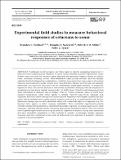Files in this item
Experimental field studies to measure behavioral responses of cetaceans to sonar
Item metadata
| dc.contributor.author | Southall, Brandon L. | |
| dc.contributor.author | Nowacek, Douglas P. | |
| dc.contributor.author | Miller, Patrick J. O. | |
| dc.contributor.author | Tyack, Peter L. | |
| dc.date.accessioned | 2016-12-07T11:30:09Z | |
| dc.date.available | 2016-12-07T11:30:09Z | |
| dc.date.issued | 2016-12-06 | |
| dc.identifier | 247346371 | |
| dc.identifier | 76adcf52-117e-4c09-bba6-435a10e61b14 | |
| dc.identifier | 000391696900005 | |
| dc.identifier | 85010461770 | |
| dc.identifier | 000391696900005 | |
| dc.identifier.citation | Southall , B L , Nowacek , D P , Miller , P J O & Tyack , P L 2016 , ' Experimental field studies to measure behavioral responses of cetaceans to sonar ' , Endangered Species Research , vol. 31 , pp. 293-315 . https://doi.org/10.3354/esr00764 | en |
| dc.identifier.issn | 1863-5407 | |
| dc.identifier.uri | https://hdl.handle.net/10023/9942 | |
| dc.description | Funding was provided by a variety of military and governmental funding sources from several nations acknowledged within referenced publications, notably the US Office of Naval Research, US Navy Living Marine Resources Program, and the navies of the USA, Norway, and the Netherlands. P.L.T. acknowledges the support of the MASTS pooling initiative (The Marine Alliance for Science and Technology for Scotland) in the completion of this study. MASTS is funded by the Scottish Funding Council (grant reference HR09011) and contributing institutions. | en |
| dc.description.abstract | Substantial recent progress has been made in directly measuring behavioral responses of free-ranging marine mammals to sound using controlled exposure experiments. Many studies were motivated by concerns about observed and potential negative effects of military sonar, including stranding events. Well-established experimental methods and increasingly sophisticated technologies have enabled fine-resolution measurement of many aspects of baseline behavior and responses to sonar. Studies have considered increasingly diverse taxa, but primarily odontocete and mysticete cetaceans that are endangered, particularly sensitive, or frequently exposed to sonar. This review focuses on recent field experiments studying cetacean responses to simulated or actual active military sonars in the 1 to 8 kHz band. Overall results demonstrate that some individuals of different species display clear yet varied responses, some of which have negative implications, while others appear to tolerate relatively high levels, although such exposures may have other consequences not measured. Responses were highly variable and may not be fully predictable with simple acoustic exposure metrics (e.g. received sound level). Rather, differences among species and individuals along with contextual aspects of exposure (e.g. behavioral state) appear to affect response probability. These controlled experiments provide critically needed documentation of identified behavioral responses occurring upon known sonar exposures, and they directly inform regulatory assessments of potential effects. They also inform more targeted opportunistic monitoring of potential responses of animals during sonar operations and have stimulated adaptations of field methods to consider increasingly realistic exposure scenarios and how contextual factors such as behavioral state and source proximity influence response type and probability. | |
| dc.format.extent | 23 | |
| dc.format.extent | 1485527 | |
| dc.language.iso | eng | |
| dc.relation.ispartof | Endangered Species Research | en |
| dc.subject | Behavioral response study | en |
| dc.subject | Sonar | en |
| dc.subject | Marine mammals | en |
| dc.subject | Controlled exposure experiment | en |
| dc.subject | QH301 Biology | en |
| dc.subject | SDG 14 - Life Below Water | en |
| dc.subject.lcc | QH301 | en |
| dc.title | Experimental field studies to measure behavioral responses of cetaceans to sonar | en |
| dc.type | Journal item | en |
| dc.contributor.institution | University of St Andrews. School of Biology | en |
| dc.contributor.institution | University of St Andrews. Sea Mammal Research Unit | en |
| dc.contributor.institution | University of St Andrews. Marine Alliance for Science & Technology Scotland | en |
| dc.contributor.institution | University of St Andrews. Scottish Oceans Institute | en |
| dc.contributor.institution | University of St Andrews. Institute of Behavioural and Neural Sciences | en |
| dc.contributor.institution | University of St Andrews. Centre for Social Learning & Cognitive Evolution | en |
| dc.contributor.institution | University of St Andrews. Bioacoustics group | en |
| dc.contributor.institution | University of St Andrews. Sound Tags Group | en |
| dc.identifier.doi | https://doi.org/10.3354/esr00764 | |
| dc.description.status | Peer reviewed | en |
This item appears in the following Collection(s)
Items in the St Andrews Research Repository are protected by copyright, with all rights reserved, unless otherwise indicated.

